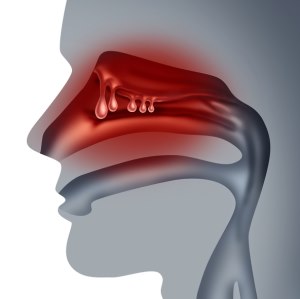Nasal Polyps
 Overview
Overview
Chronic rhinosinusitis (CRS) is one of the most common medical conditions worldwide, reported to affect almost 12% of the adult population. It is characterized by inflammation of the nose and sinus cavities. About 20% of patients with CRS have nasal polyps, benign growths in the nasal cavities that are thought to originate from the ethmoid sinuses. Nasal polyps tend to be present in both sides of the nasal cavity. One-sided nasal polyps may need to be investigated further as they might be malignant nasal or sinus tumors.
The exact cause of chronic rhinosinusitis with nasal polyps (CRSwNP) is unknown but biopsy of nasal polyp tissue in the western population demonstrates an elevated allergic type of cells known as eosinophils. Infection may also play a role, especially by bacteria called Staphylococcus aureus. Typically, nasal polyps develop in adulthood in the 30s or 40s.
Symptoms
Symptoms of CRSwNP include nasal drainage, nasal congestion, facial pressure or pain, and a decrease in sense of smell lasting for more than 12 weeks. Of all the symptoms, nasal congestion and loss of smell tend to be the most bothersome.
Diagnosis
The diagnosis of nasal polyps is based on a combination of history, physical examination and often a sinus CT scan. The history of nasal congestion and loss of smell points to nasal polyps. Nasal examination often by nasal endoscopy confirms the diagnosis of nasal polyps and distinguishes patients with CRS without nasal polyps from patients with CRSwNP. A sinus CT scan is helpful because it documents the extent of sinus disease.
Conditions Associated with Nasal Polyps
CRSwNP is often associated with other medical conditions. It is important to recognize and appropriately treat these conditions as they can be serious diseases and also influence the severity of sinus disease.
Asthma occurs in 26 to 56% of patients with CRSwNP. A subgroup of patients with asthma and nasal polyps develop worsening nasal symptoms and/or breathing problems upon ingestion of aspirin or other nonsteroidals. This condition is called aspirin exacerbated respiratory disease (AERD) and affects about 10% of patients with CRSwNP. Patients with AERD tend to have severe sinus disease and often difficult to control asthma.
Allergic fungal rhinosinusitis (AFRS) is observed in about 5 to 10% of patients undergoing sinus surgery. AFRS is due to an allergic response to inhaled fungi in a predisposed individual with nasal polyps. Patients with AFRS typically develop nasal congestion and have thick “peanut buttery” discharge. Sinus CT scans and MRIs have classic findings that are characteristic of AFRS. This condition tends to occur more often in the southern United States and along the Mississippi River Basin. Surgery to improve sinus drainage is often necessary in these patients.
Cystic fibrosis is another condition associated with nasal polyps. Most polyps present in adulthood, however their presence in children should raise concerns for cystic fibrosis which is a condition with severe upper and lower respiratory infections. Nasal polyps are present in up to 86% of patients with cystic fibrosis.
Management and Treatment
Medical treatment of CRSwNP includes both topical nasal steroid sprays and nasal saline rinses. Steroid sprays help reduce polyp size and improve symptoms and are very safe for long-term use. Short courses of oral steroids can also help shrink nasal polyps and have shown to improve symptoms including sense of smell, however they should be used cautiously given the risk of steroid side effects. Sinus surgery to remove polyps is an option if nasal polyps are bothersome despite oral and/or corticosteroid sprays. Unfortunately, polyps often recur despite surgery and long-term treatment with nasal steroids or large volume steroids are often necessary.
More recently, different steroid delivery options have been utilized for treatment of CRSwNP. Large volume nasal steroid rinses with squeeze plastic bottles have been shown to be superior to traditional steroid sprays. Exhalation delivery system with fluticasone is a recently approved steroid device that sprays fluticasone deeper into the nasal cavity to reduce inflammation from nasal polyps. Stents that deliver topical steroids can also be inserted by surgeons and have shown benefit in reducing polyp recurrence.
Other medications that have shown some benefit in the treatment of nasal polyps include leukotriene inhibitors such as montelukast. Additionally, antibiotics are occasionally prescribed if there is a concern for infection although there is not much scientific evidence for their efficacy. Finally, biologic medications (dupilumab, mepolizumab and omalizumab), which have been approved to treat moderate to severe asthma, have also gained approval to treat CRSwNP. These are given as injections every 2-4 weeks and have been shown to reduce the need for surgery and treatment with oral steroids.
CRSwNP is often co-managed by allergists and otolaryngologists.
12/27/2023